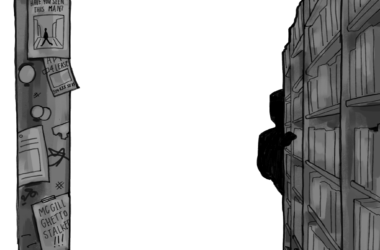On a recent Wednesday morning in Chicago, three of the city’s veteran newspaper editors sat around a desk in a small office eight floors above Lake Street, talking about story ideas. The men—Jim Kirk, David Greising, and Bill Parker, all in shirtsleeves—were discussing how to cover the trial of Rod Blagojevich, the former Illinois governor, when Dan Mihalopoulos poked his head through the doorway. “Hey,” he said in a soft voice. “We just got a tip Rosty died.”
Dropping Blagojevich, the editors immediately pivoted to deal with the news that Rosty—Dan Rostenkowski, the powerful Chicago congressman who reigned over the House’s Ways and Means Committee in the 1980s—had passed away. The story hadn’t yet broken on the websites of either the Chicago Tribune or the Sun-Times, the city’s two daily newspapers, but the editors guessed it would soon. As Mihalopoulos rushed off to confirm the news and file a story for the Internet, Kirk, Greising, and Parker began discussing how to take a fresh angle on the still-breaking story.
Along with James O’Shea, the three editors in the office that morning head up the Chicago News Cooperative, the city’s newest newsroom. Conceived and founded last year by O’Shea, a longtime Chicago journalist, the CNC is a nonprofit news outlet that began producing pages for the New York Times’ Chicago edition in November. Since then, the organization has become one of the first planks in the Times’ strategy to expand its local coverage in cities across the Unites States. As America’s big-city dailies lay off reporters and slash their metropolitan coverage, the Times is contracting with online outlets like the CNC to fill the void.
The CNC, Parker said in an interview last month, is a distinctly Chicago organization, dedicated to covering the colour and personality of the city. But the conversation that led to the start-up’s founding, oddly enough, took place two years ago at Yankee Stadium in New York.
In 2008, Peter Osnos, a former editor at the Washington Post and the founder of Public Affairs Books, a New York publishing house, attended a Yankees game with several Chicago friends. Osnos’ son, Evan, a foreign correspondent for the Chicago Tribune, had decided to leave the paper for the New Yorker, and the topic of Chicago’s newspapers came up at the ballgame. Sam Zell, a Chicago real estate mogul, had bought the Tribune several months before and was taking it in a direction neither Osnos nor his son approved of. His friends at the game, though, didn’t seem too perturbed. “The two great newspapers in Chicago were in the process of being gutted,” said Osnos, a distinguished-looking man in khakis and a button-down, at his offices overlooking 57th Street in Manhattan on a recent afternoon. “I was stunned, and kind of dismayed, that they didn’t know what was at stake.”
One of Osnos’ friends at the game that afternoon was Martin J. Koldyke, a prominent Chicago figure and the former chairman of the board of Chicago’s public television station. If Osnos thought the decline of Chicago media was such a problem, Koldyke said, then why didn’t he come up with a plan to do something about it? That summer, Osnos did just that. At his house in Lakeside, Michigan, across the lake from Chicago, he drafted a memo in which he envisioned a new type of Chicago news outlet—”a Web-based news-gathering enterprise that would augment public radio and television.” And over the next year, Osnos, Koldyke, and a few others began searching for someone to lead the start-up.
After talking to several people, Osnos called James O’Shea, a former editor at the Tribune who had previously helmed the Los Angeles Times, in June 2009. At the time, O’Shea was finishing up a fellowship at Harvard’s Joan Shorenstein Center on the Press, Politics, and Public Policy. Osnos knew him because he was writing a book about Sam Zell’s purchase of the Tribune—tentatively titled “The Deal from Hell”—for Public Affairs Books. When Osnos phoned him, O’Shea said, “I agreed that I would help become a catalyst to help get this thing off the ground.”
The Chicago start-up was, at this point, still little more than an idea. The organization, O’Shea said, had no money and only the germ of a business model. But at the same time Osnos was recruiting O’Shea, editors at the New York Times were working on their own designs for the Chicago news market. The Times, said Jim Schachter, an associate managing editor there, had some hints at the time that the Wall Street Journal was planning to start regional coverage of Chicago and San Francisco. “They’re our primary national newspaper competitor,” Schachter continued, “and we don’t like them to beat us at anything. It’s not good.”
Back in Chicago, Monica Davey, the Times’ Chicago bureau chief, had heard about O’Shea’s plans to launch a start-up and mentioned them to Schachter. Could the Times perhaps collaborate with the start-up? “My attention was caught,” Schachter said, “because the notion of having an editor who editors here knew and respected at the other end of the phone really eases the way for an arrangement like this.”
After speaking with Schachter, O’Shea flew to New York and met with Bill Keller, the Times’ executive editor, a conversation Schachter laughingly likened to George W. Bush sitting down with Vladimir Putin. With Osnos’ help, the two men struck a tentative deal: if O’Shea could put together a business plan by September 1, the Times would help the new organization get started.
When he returned to Chicago, O’Shea moved quickly, approaching the MacArthur Foundation to ask for a seed investment. “Amazingly, within three weeks,” he said, “they approved a $500,000 grant.” With the support of Osnos, Koldyke, and other influential Chicagoans, several organizations in the city chipped in to help the CNC get started. WTTW, the public television station, agreed to host the CNC under its nonprofit umbrella, and Winston & Strawn, a Chicago law firm, provided legal services pro bono. With the funding from the Times and the MacArthur Foundation, O’Shea had enough money to get started.
To staff the start-up, O’Shea took advantage of the large pool of disaffected current and former Tribune reporters and editors. “I had in mind some of the people I was going to go after,” he said. “One of them was Dan Mihalopoulos,” a City Hall reporter at the Tribune who was one of O’Shea’s first CNC hires. He also recruited Katie Fretland, a former Tribune reporter who had left for the Omaha World-Herald, to join Mihalopoulos at City Hall. The start-up’s top editors came from the Tribune as well. Bill Parker, for instance, a bespectacled deputy editor for the CNC with silver hair and a serious demeanor, had buyout offer from the Tribune after more than three decades there. “I was struck by the direction the paper went, and not pleasantly,” he said. “It made me angry, and it made me very sad. I think that was true for both me and many of my colleagues who left the paper after the Zell transaction.”
The CNC published its first two pages in the New York Times on Friday, November 20, with the lead story about the tremendous profits netted by the company running Chicago’s parking metres, written by Dan Mihalopoulos. In its first nine months of operation, O’Shea said, the CNC has covered the types of stories the Tribune no longer goes after. “We’ve focused, initially at least, on areas we feel the major dailies have backed out of, such as City Hall,” he said. “Anybody who covers Chicago has to cover that. We now have three people covering city and county government. And frankly, that’s more than the Tribune does.”
Seated behind the white Formica desk in his office—a small glass Pulitzer Prize rests inconspicuously on one corner— O’Shea spoke glowingly about a recent piece on La Familia Michoacana, a Mexican drug cartel that kidnaps family members of Mexicans in the Chicago area and holds them for ransom in Mexico. Neither the Tribune nor the Sun-Times had covered the st
ory, he said. The CNC has also concentrated on cultural coverage. A December story by a CNC staff writer, Jessica Reaves, probed the reasons Chicago’s Steppenwolf Theatre Company has been able to send the casts of its Chicago productions to Broadway, rather than replacing them with more famous actors.
Because the CNC’s content appears only twice a week in the Times, the start-up is often forced to cover issues in innovative ways. When Mihalopoulos got the Rostenkowski tip, for example, Kirk, Greising, and Parker quickly diced the possibilities. Both the Tribune and the Times would run comprehensive obituaries, Greising said, but maybe James Warren would be interested in writing a column about it. Parker then called Warren, the Tribune’s former Washington correspondent and a columnist for the CNC. Though he was on vacation in Michigan at the time, Warren agreed to write about Rostenkowski.
Warren’s column, which appeared two days later in the Friday edition, was unlike anything else in the Times that day. In it, Warren reminisced about a meal with Rostenkowski in a distinctly Chicago voice, calling him the “grand poobah of Congress.” But Times editors often let such terminology—such as referring to Rod Blagojevich, the former governor, as “Blago”—slide on the CNC’s pages. “You don’t want the pages to look like you’re doing Chicago from New York,” said Jill Agostino, an assistant national editor at the Times who coordinates with the CNC on a daily basis. “Even though it looks like the New York Times, it’s got to feel like you’re doing Chicago from Chicago.”
The Tribune and the Sun-Times have not been the only American newspapers to slash their news budgets in recent years. But both the Times and the Wall Street Journal seem to see opportunity in hard-hit newspaper markets. In October, the Times launched a local-content edition in the Bay Area, where the daily papers, the San Francisco Chronicle and the San Jose Mercury News, have both seen severe cutbacks. (The content for that edition, initially produced by Times reporters and freelancers, is currently provided by the Bay Citizen, an online start-up with ties to the University of California, Berkeley.) The Wall Street Journal launched its own San Francisco edition in November.
This fall, the Times will debut its third local edition in Austin, Texas, in partnership with an online start-up called the Texas Tribune. In the next few years, the Times is considering launching up to a dozen more local editions in major cities if it finds suitable partners. “The goal of these zoned editions,” Schachter said, “is to stop [our national circulation] decline and, if possible, grow a little bit.” While Schachter declined to provide any numbers, O’Shea said the Times’ circulation in Chicago had risen modestly, with about 800 new subscriptions. “In their minds, this here has been very successful,” he added. “They’re selling more ads than they thought they would. They were hoping they would just flatten out their readership, but it’s actually up.”
The CNC’s plans, however, include more than just providing content to the Times. “We’d like CNC itself to have its own identity and to be viewed as a source of enterprising, substantive, original journalism in Chicago,” said David Greising, the CNC’s general manager and a deputy editor,”We’d like the New York Times to be part of that, but not the sum and substance of it.” In October, the organization plans to launch a new website that it hopes will bring in more advertising revenue, which in turn will enable it to produce more content. And in January, O’Shea hopes to debut his most original idea, which he calls news-interest networks—social networking sites based around a specific area of the news in which readers might be interested, such as education. Members will be charged $2 per week to subscribe.
Taken together, the CNC’s modus operandi—relying on revenue from Web advertising, content sales to the Times, and the news-interest networks—could deliver what inspired Osnos to start the outlet in the first place: a new business model for news organizations. The prospect, Greising said, is both daunting and exhilarating. “Part of the excitement and challenge is that because nobody’s done it, it’ll be fun when we break through with something,” he added. “It’s an invigorating thing to be involved with.”








